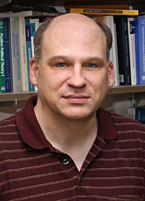Inside Iowa State | ||
Inside ArchivesSubmit newsSend news for Inside to inside@iastate.edu, or call (515) 294-7065. See publication dates, deadlines. About InsideInside Iowa State, a newspaper for faculty and staff, is published by the Office of University Relations. |
August 12, 2004 Pols face new world in money and pollsby Karen Bolluyt Cell phones are creating new headaches for politicians and pollsters and making it more difficult to get accurate data, according to ISU political scientist Robert Lowry. Draw a polling sample from the phone book and you miss many people who rely mostly or entirely on cell phones. Use random digit dialing and you live with sampling errors caused because sampling methods are not keeping up with the fast-changing world of numbering systems used for cell phones. The reliability of poll numbers depends on the degree to which those who respond represent those who do not. According to Lowry, there is no good new methodology to address the problems created by increased consumer reliance on cell phones. Cell phone users make a long-time problem worse. Lowry noted a recent Washington Post report that pollsters often must make seven or eight calls for every respondent finally reached for a poll. Other information important to people like Lowry, who study polling methodology, and to those who read polls includes: When was the poll taken? How was the sample drawn? How was the sample defined? For example, what is a "likely voter"? Iowa caucus pollsLast fall, Lowry was the principal investigator for a survey of registered Democrats in Iowa. Democrats were asked if they would definitely or probably vote in the Iowa caucuses. Approximately27 percent of those who responded said "yes." That shows the problem with using self-identified likely voters. Actual turnout, including those who registered at the caucuses, was much lower than that, Lowry said. His research also illustrated the importance of timing. In November, among Lowry's respondents, the top candidate for people who said they probably would participate in the caucuses was Howard Dean. But even in January, no poll accurately projected the high turnout for caucus winner John Kerry and runner-up John Edwards. Lowry noted that this can happen because pollsters do not have the names of people who will participate for the first time. Parties, pollsters use different databasesParties may have an advantage, compared with major polling firms, in database management. Party volunteers with hand-held computers go door to door to confirm addresses for previous voters and to identify new voters. Lowry said voter data, useful in polling and fundraising, gave Republicans a big advantage until recently. Beginning in the late 70s, the party built up a sophisticated direct-mail operation and was much more effective than Democrats in soliciting relatively small donations from a large number of people. "Until McCain-Feingold [federal campaign-finance legislation] changed the rules, Democrats relied heavily on large soft-money contributions to the party. The new rules forced the party to develop better data bases to reach large numbers of people," Lowry said. This is part of a big change that Lowry is following with interest this election cycle. And, he added, Democrats gained the lead, most visibly in Howard Dean's primary campaign, in using the Internet to raise funds. So, in Lowry's estimation, the Republican Party no longer has a big advantage in its voter and donor databases. Campaign finance focus of faculty improvement leaveLowry will spend the 2004-05 academic year at Harvard University, working on studies of how both parties are adjusting to new campaign finance laws and regulations. "We want to know who is giving money to parties. Who is giving to PACs (political action committees). Who is giving to candidates. What are the strategies in raising and spending money? Are they effective?" Parties and PACs are heavily regulated, so the data on those are the easiest to get at the national level. However, once national party money goes to states, it can be hard to track. "That is likely to be one of our challenges," Lowry said. Any insight for donors? One of Lowry's conclusions is that, in general, business and trade PACs donate to incumbents because they like friends in power. Parties, however, only like some incumbents--their own. So to try to shake things up a bit in Washington, contribute to your party, perhaps at the national rather than the state level. To keep things as they are, a PAC may be your best bet. Of course, donors do not have complete freedom to make donations. Laws and regulations affect how much may be given to different types of organizations and how the organizations may spend the money. "Laws are different for PACs and political parties. In examining these laws, I think it's worth keeping in mind that different organizations affect the process differently, "Lowry said. A new wrinkleOrganizations commonly called "527s," after the section of the tax code that applies to them, have gained prominence in this election cycle. By law, these organizations may not coordinate with political parties or candidates, but they are run by political activists who raise money to promote a point of view. MoveOn.org is one prominent example. "The 527s are examples of the unintended consequences of McCain-Feingold. In this election cycle they will raise a lot of money without the regulations that govern parties and PACs," Lowry said. |

Robert Lowry SummaryTimes are changing for political parties. Cell phones are creating new headaches for pollsters and making it harder to get accurate data. And both major parties are trying to adjust to new campaign finance laws and regulations.
|
|
Ames, Iowa 50011, (515) 294-4111. Published by: University Relations, online@iastate.edu. Copyright © 1995-2004, Iowa State University of Science and Technology. All rights reserved. |
||